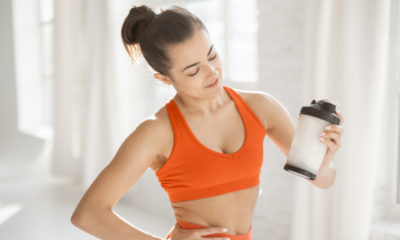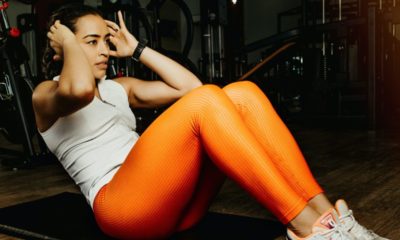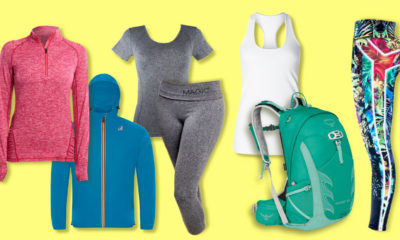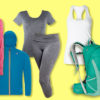Beauty
Here’s How To Care For Your Skin Pre And Post Workout
A good sweat session is essential for skin health but the trappings of modern womanhood could be causing exercise-related breakouts. Here’s how to fix your bumps.
Acne is one of the most common skin conditions worldwide, with 60 million Americans being affected by it and 28% of the United Kingdom’s population suffering from this at some stage in their lives, which can pose both physical and mental challenges. One particular cause that can’t go unnoticed is the onset of acne and acne related conditions thanks to excessive exercise. While working out does offer a myriad of health benefits, many of us are succumbing to skin problems by not taking good care of our skin when exercising. Here are the reasons why.
Not removing make-up
It is best to remove make-up before exercise as it forms a barrier on your skin and can block your pores. As you exercise your body temperature rises and your heart rate increases, causing your pores and sweat glands to open up, helping to cool your body down. If make-up is left on it may prevent those pores from being able to release sweat. Therefore, wearing a full face of make-up when exercising can block your pores and glands, hindering your skin’s ability to breathe, which in turn can increase the chance of breakouts and blackheads developing.
Tight clothing
Gear that occludes the pores and prevents sweat from escaping can also contribute to nasty outbreaks. Exercise-induced acne is more prevalent on areas of skin that are obstructed by constricting clothing, such as bra straps, waistbands, rucksacks or under headbands or devices such as watches or heart rate monitors. The most effective form of treatment consists of removing the cause of the issue. As such, devices or objects in contact with the affected skin should be removed as soon as you have finished using them and should be cleaned after use. Where possible, avoid wearing clothing which rubs against your skin during exercise and ensure you shower or bath straight after exercising and change into clean clothing. Wearing breathable fabrics, such as cotton and linen will help to keep you cooler by absorbing the excess moisture, which in turn will reduce sweating. Clothing with modern fabric technology such as sweat wicking, is also a good option as it has been designed to help people keep cool and draw moisture away from the body to allow it to evaporate quickly and easily, ensuring that it doesn’t linger on the skin and block the pores.
Exercising outdoors
Prolonged sun exposure from exercising outdoors can also cause premature skin ageing, not to mention skin cancer. If exercising outdoors in hot weather, ensure you wear a sun cream which protects you against both UVA and UVB rays. If possible, also try and opt for an oil-free non-comedogenic sunscreen that’s formulated for the face and apply your chosen, broad spectrum sunscreen at least 30 minutes before you go outside and reapply every 2 or 3 hours throughout the day, and after excessive sweating or swimming. Even if you don’t normally burn easily, regardless of your skin type, applying the correct sunscreen in sunny weather is important in preventing serious sun damage, which can occur over a lifetime, due to over exposure and lack of sun protection. There are also a large number of other skin conditions which can be aggravated by sun exposure, including eczema, psoriasis, acne and some auto immune conditions. These may be induced with extensive exercise, for example after prolonged periods of walking (symptoms are often found in golfers, marathon runners or long-distance walkers), usually in hot weather.
Shared equipment
Gym equipment from exercise mats, to dumbbells and running machines, can be a source of skin infections. As is common in medicine, there is mixed evidence on this subject with some publications showing little growth of pathogenic (disease causing) bacteria, whereas others clearly illustrate evidence of bacteria and viruses on gym equipment. Studies show that gym equipment which have the most contact with the skin, such as mats and exercise machines have the most changes in bacteria. With so many people using the same machines on a regular basis and not paying enough attention to disinfecting or wiping down after use, these germs and bacteria are easily spread. People with compromised immune systems have also been shown to have more risk of developing skin infections if they attend the gym. It is important to remember, exercise significantly helps to reduce stress levels and release endorphins. Exercise can even make you genetically younger and as such can have a positive effect on your skin. Those suffering from exercise-induced skin problems should not give up exercising, but may need to take preventative measures to avoid future flare-ups. If you’ve noticed a significant change in your skin since exercising and you are concerned about what you see, be sure to seek the professional help of an expert dermatologist who can offer a bespoke treatment plan for you.
Troubleshoot your breakout
1. Cleanse after your workout and shower straight away – If you can’t work out without make-up, then cleanse as soon as you can. This washes away any bacteria and helps open up any blocked pores that may have built up during your workout.
2. Keep cool – If you are exercising outside, only do so in the early morning or evening. If you are working out inside, aim for areas with air-con as heat and humidity can cause stress to the skin, increasing surface oil and blocking pores.
3. Choose your moisturizer wisely – Make sure you choose products free from fragrances, preservatives, and other ingredients as these can further aggravate and irritate skin, increasing the risk of breakout.














